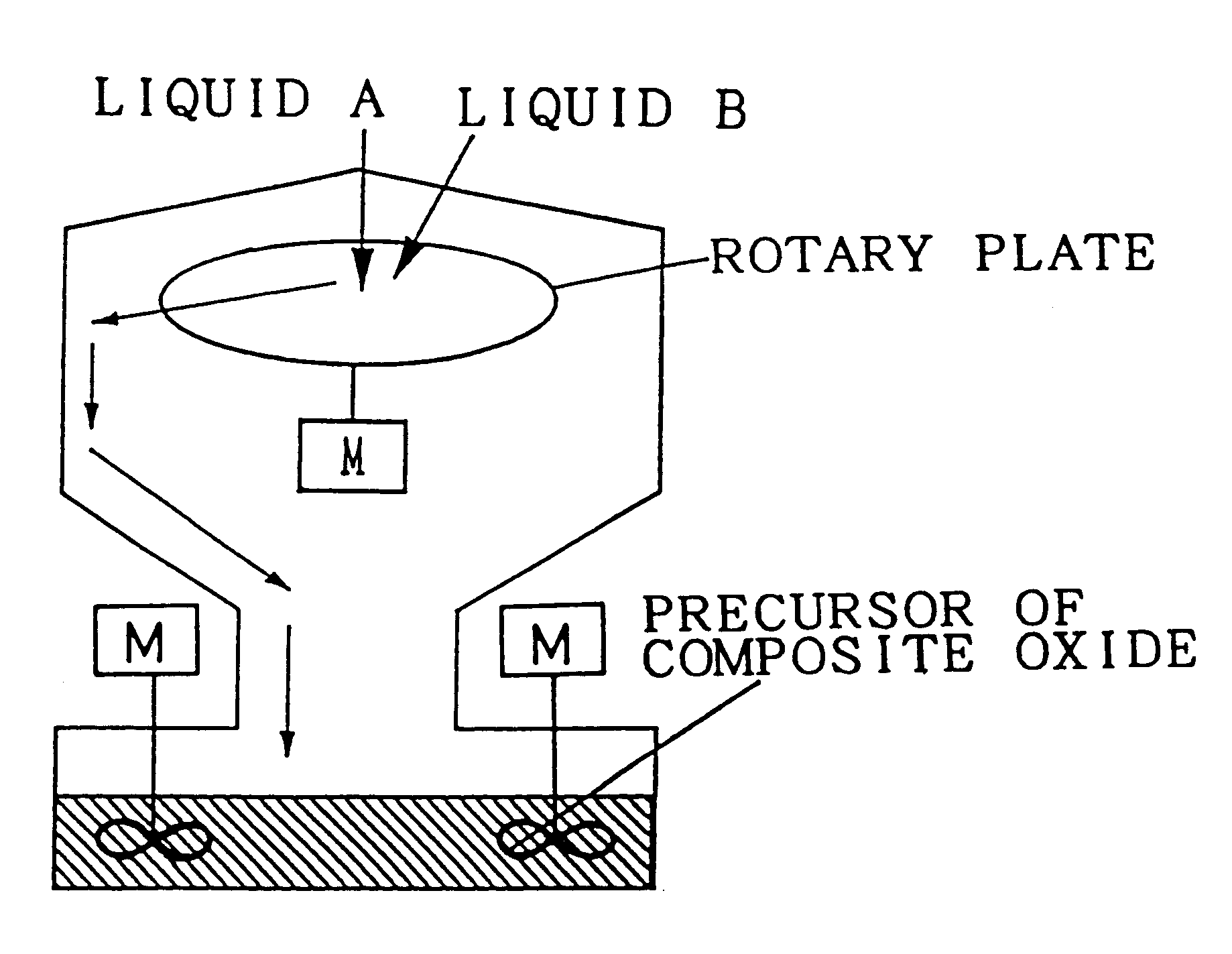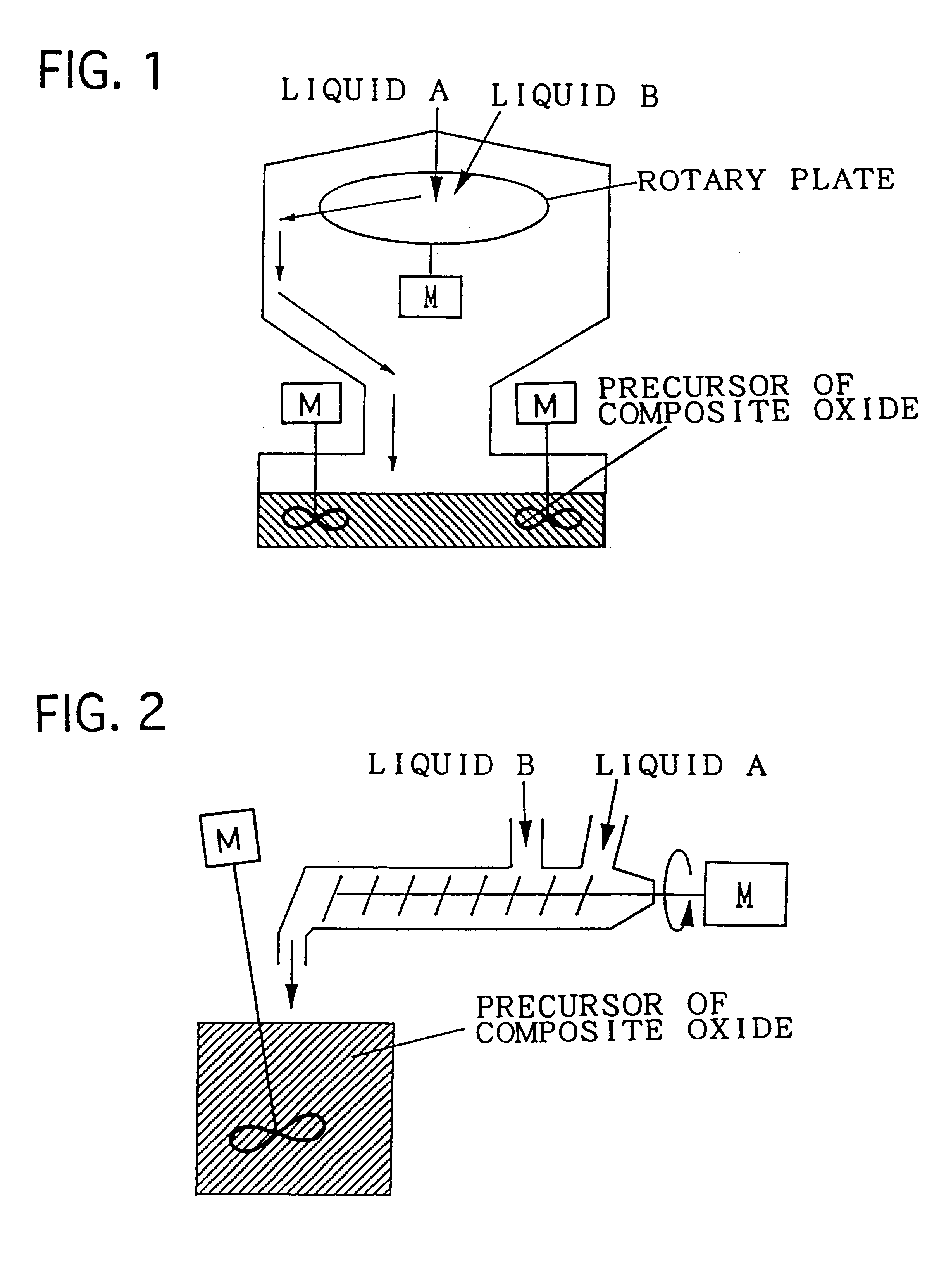Composite oxide, composite oxide carrier and catalyst
a composite oxide and catalyst technology, applied in the direction of catalyst activation/preparation, metal/metal-oxide/metal-hydroxide catalyst, etc., can solve the problems of unfavorable accelerated deterioration (coagulation and dissolution) of active catalytic metals (platinum, palladium and rhodium), the dispersion characteristics of composite oxide carriers of which component elements exhibit high dispersibility characteristics, and the inability to manufactur
- Summary
- Abstract
- Description
- Claims
- Application Information
AI Technical Summary
Benefits of technology
Problems solved by technology
Method used
Image
Examples
embodiment 1
A catalyst was prepared by the method similar to that of Embodiment 1 except that the liquids A and B were added slowly (in about 1 minute) while measuring the pH value without using the high speed mixing means. The characteristics of this catalyst are also shown in TABLE 1.
Evaluation of Catalytic Property
The catalysts, each having a catalyst volume of 1.7 liter, which were prepared in Embodiments 1 through 7, were respectively installed in an exhaust pipe of an automobile provided with a gasoline engine having a cylinder volume of 2 liters, and an accelerated endurance running test was carried out at about 980.degree. C. which is the maximum catalyst bed temperature, simulating the European running, for 200 hours. Next, analysis of exhaust gases discharged while simulating the European running was carried out at both the upper stream and downstream of each catalyst, and the average ratios of purification of the components of the exhaust gases (NOx, HC, CO) were measured. As a resul...
embodiment 8
Mixing Step
The liquids A and B which were respectively identical to those of Embodiment 1 were mixed homogeneously within two seconds by stirring at a high speed, similarly to Embodiment 1, to precipitate a precursor of composite oxide.
Separating Step
The following decantation step was performed. While stirring a mixed liquid containing the above-described precursor, an aqueous solution in which 0.5 g of ammonium carbonate was dissolved per liter of deionixed water was added thereto to dilute a resultant liquid to five times. 12 liter of an aqueous solution containing 0.1% of a high-molecular coagulant (flocculant) (manufactured by SANYO CHEMICAL INDUSTRIES, LTD., trade name: Sanfloc) was added to a resultant diluted liquid. The diluted liquid was gently stirred uniformly at a rate of about 40 rpm and allowed to stand for about 20 minutes. Next, supernatant was eliminated therefrom. These steps were repeated several times, whereby the amount of impurities (ammonium nitrate) within th...
embodiment 9
A catalyst was prepared by the method similar to that of Embodiment 8 except that no separating step was included and the drying step was carried out at 200.degree. C. The characteristics of this catalyst are also shown in TABLE 2.
Evaluation of Catalytic Property
Catalysts composed of the carriers of Embodiments 8 and 9 and carrying catalytic metals, each having a catalyst volume of 1.7 liter, were respectively installed in an exhaust pipe of an automobile provided with a gasoline engine having a cylinder volume of 2 liters, and an accelerated endurance running test was performed at about 980.degree. C. which is the maximum catalyst bed temperature, simulating the European running, for 200 hours. Next, analysis of the exhaust gases discharged while simulating the European running was carried out at both the upper stream and downstream of each catalyst, and the average rates of purification of the components of the exhaust gases (NOx, HC, CO) were measured. As a result, the average ra...
PUM
| Property | Measurement | Unit |
|---|---|---|
| crystallite diameter | aaaaa | aaaaa |
| particle diameter | aaaaa | aaaaa |
| size | aaaaa | aaaaa |
Abstract
Description
Claims
Application Information
 Login to View More
Login to View More - R&D
- Intellectual Property
- Life Sciences
- Materials
- Tech Scout
- Unparalleled Data Quality
- Higher Quality Content
- 60% Fewer Hallucinations
Browse by: Latest US Patents, China's latest patents, Technical Efficacy Thesaurus, Application Domain, Technology Topic, Popular Technical Reports.
© 2025 PatSnap. All rights reserved.Legal|Privacy policy|Modern Slavery Act Transparency Statement|Sitemap|About US| Contact US: help@patsnap.com


